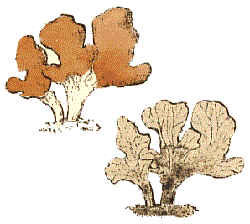|
History of Australian Lichenology
The pages under this heading will give you a good idea of how knowledge about Australian lichens has advanced. However, these pages really present just episodes in the history of the study of Australian lichens. Nothing approaching a comprehensive history of Australian lichenology has yet been published and these web-pages won't attempt to do so. Such an account would demand considerable space, especially when it comes to the later 20th century which has seen a resurgence in studies of Australian lichens, by both Australian and overseas lichenologists.
The first publication to mention an Australian lichen appeared in 1806 and for much of the 19th century the study of Australian lichens was dominated by Europeans. Initially much of the collecting of specimens was done by European visitors, with the specimens being sent back to Europe for study. Many of those specimens still exist and are held in various European herbaria. By the mid 1800s resident Australians were collecting lichens for scientific study, but it was still a case of the specimens being sent to Europe with the scientific study being undertaken there. It was not until the 1880s that resident Australians began the serious study of the country's lichens and the publication of their findings in Australian scientific journals. The first half of the 20th century saw little in the way of the study of Australian lichens but the later years, especially the 1960s and later, have seen great advances in the knowledge of Australia's lichens. Moreover, there is an active Australian lichenological community and a productive collaboration between Australian and overseas lichenologists.
This historical account is given over two web-pages, which you can reach via the following links
The early years
This takes the story to about 1900.
The later years
In principle this page picks up the story from about 1900, but nothing much happened for a few decades.
I have borrowed heavily from the following papers and my borrowings permeate the two linked web pages.
Filson, RB. (1976). Australian lichenology: a brief history. Muelleria, 3, 183-190.
Filson, RB. (1992). History of Australian lichenology. Flora of Australia, 54, 2-11.
Galloway, DJ. (2008). Austral lichenology: 1690- 2008. New Zealand Journal of Botany, 46, 433-521.
Kantvilas, G. (1983). A brief history of lichenology in Tasmania. Papers and Proceedings of the Royal Society of Tasmania, 117, 41-51.
Filson's 1976 paper deals largely with the period up to the mid-1900s. The 1976 paper is included, albeit modified, in Filson's 1992 paper which concludes with two pages dealing with the second half of the 20th century. The Kantvilas paper includes material that appears in neither of the Filson papers so that overall, despite some overlap, those three papers are complementary. Galloway's paper gives an overview of the lichenology of the temperate southern hemisphere, not just Australia. Moreover, it deals with subjects additional to history so that, in terms of the history of Australian lichenology, Galloway does not give the Australian detail that you can find in the Filson and Kantvilas papers. Nevertheless, the historical part of Galloway's paper is well worth reading. It puts the Australian history in the context of the history of southern hemisphere lichenology.
History of Australian lichenology pages on this website |
![An Australian Government Initiative [logo]](/images/austgovt_brown_90px.gif)


